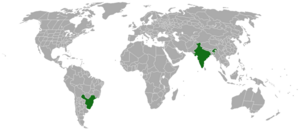Angico facts for kids
Quick facts for kids Angico |
|
|---|---|
 |
|
| Scientific classification | |
| Genus: |
Parapiptadenia
|
| Species: |
rigida
|
 |
|
| Range of Parapiptadenia rigida | |
| Synonyms | |
|
|
Parapiptadenia rigida is a type of tree or shrub that grows year after year. It is not currently in danger of disappearing. You can find it naturally in countries like Argentina, Brazil, Paraguay, and Uruguay. People call it by many names, including angico, angico-cedro, and guarucaia. In Spanish, "angico" becomes "anchico."
This tree can grow quite tall, usually between 18 and 30 meters (about 60 to 100 feet). It has a straight trunk with bark that's a little bit grooved. Its leaves are dark green, and its flowers are greenish-yellow, about 5 to 9 centimeters (2 to 3.5 inches) long. It blooms in the spring. The seed pods grow 9 to 16 centimeters (3.5 to 6 inches) long. The seeds inside are flat, oval, and brown. You can often find this tree growing along rivers.
Contents
Uses of the Angico Tree
Natural Products
The Parapiptadenia rigida tree offers several useful products.
Fragrant Oils
Special oils from this tree are becoming popular. They are used to create scents and fragrances in different products.
Natural Gum
The tree produces a type of gum. This gum can be used in similar ways to gum arabic, which is a natural gum often used in food and other industries.
Traditional Medicine
In some areas, parts of the tree have been used in traditional medicine. For example, in southern Brazil, it is used for its antiseptic properties. This means it can help clean and protect against germs. The bark of the tree has a high amount of a substance called tannin. This tannin-rich bark has been used as a bitter-tasting tonic.
Strong Wood
The wood from the Parapiptadenia rigida tree is very strong and dense. It can resist different weather conditions. Because of its strength, it is used for many things.
Building and Construction
People use this wood for building houses and other structures. It's also good for making furniture and beams for bridges. It can even be used for poles and firewood. The wood is known to be very tough. It is said to be unaffected by insects like termites. This means it can last for more than 20 years, even without paint.
Wood Strength Facts
The wood is very hard. Its "Janka Hardness" is between 2300 and 3700 pounds. This measures how much force is needed to embed a steel ball into the wood. It also has a high "bending strength" and "compression strength." This means it can handle a lot of pressure without breaking. Its density is between 720 and 1199 kilograms per cubic meter. This is measured when the wood has a moisture content of 12-15%. For hardwood floors, this wood is sometimes called "pepperwood."
See also
 In Spanish: Parapiptadenia rigida para niños
In Spanish: Parapiptadenia rigida para niños

